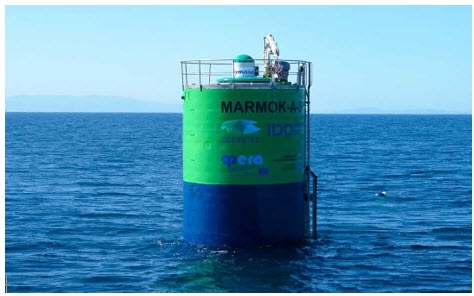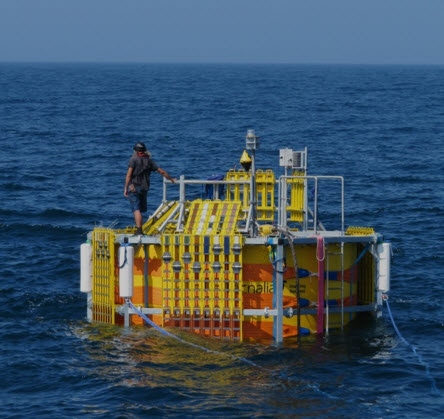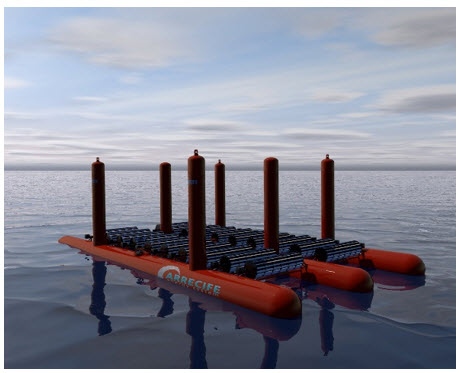SPAIN
TECHNOLOGY DEMONSTRATION
PROJECTS IN THE WATER
BiMEP is an open sea test area located off the coast of Armintza, in the province of Bizkaia. Operating since June 2015, BiMEP offers technology developers an offshore area with suitable wave and wind resources, thereby enabling the demonstration and validation of the technical and economic viability of different concepts of energy converters, equipment and materials prior to commercial development.
 MARMOK-A-5 device deployed by IDOM at BIMEP after refitting with OPERA innovations MARMOK-A-5 device deployed by IDOM at BIMEP after refitting with OPERA innovations |
BIMEP hosts the first floating wave energy device connected to the grid in Spain. The so called MARMOK-A-5 device developed by OCEANTEC (acquired by IDOM in September 2018) was initially installed in 2016.
After surviving two winters, the device was towed in for refitting and integration of the different innovations that have been developed in the OPERA project.
In October 2018, the device was returned to it mooring site at BIMEP to collect more data for benchmarking.
- the oceanographic buoy ANTEIA, developed by the company ZUNIBAL, has been tested at BIMEP obtaining very good results to collect, in real time, height, direction and period data, as well as the water temperature;
- IK4-AZTERLAN and TECNALIA also developed some material tests, the former under the OCEANIC project funded by OCEANERA-NET.
PLOCAN offers a test site for marine energy converters among other uses. It includes an offshore multipurpose platform providing workshops, laboratories, classrooms, training rooms and open working areas around a test tank to facilitate sea trials and launching vehicle to the sea.The installation of two submarine cables (5 MW/13,2 kV) started in 2017 and was commissioned during 2018. They are expected to be grid connected in 2019. Some testing developed during 2018: TORGUER POWER (Norwish water pumping device)
Mutriku Wave Power Plant is the first multi-turbine wave energy facility in the world. It is integrated with the breakwater of Mutriku (Basque Country) and based on the OWC (Oscillating Water Column) principle. It has 16 air chambers and 16 sets of “Wells turbines + electrical generator” of 18.5 kW each. The plant was connected to the grid in July 2011, reaching a record of cumulative energy from waves powered to the grid of some 1.77 GWh. Two of the air chambers are prepared to test OWC components (air turbines, electrical generators, power converters and control systems). Until August 2018, the Portuguese company Kymaner continued testing its bi-radial air turbine. This novel turbine was completely designed and manufactured in Portugal, with a total investment value of circa €1 million, and represents the culmination of the development of a patent originated in IST- Instituto Superior Técnico, protected in several countries interested in wave energy. The turbine prototype has been specifically developed and tested under the EU project OPERA. Mutriku wave power plant has also adapted its premises to better host technology developers during their tests.
 HarshLab deployed by TECNALIA at BIMEP during an inspection HarshLab deployed by TECNALIA at BIMEP during an inspection |
HarshLab is an advanced floating laboratory for the evaluation of standardized probes and components in an offshore environment developed by TECNALIA. It is suitable to test new materials and solutions against corrosion, ageing and fouling in real and monitored conditions.
The first version of HarshLab was installed at BIMEP in September 2018. It can handle up to 125 samples in atmospheric zone, 320 in splash and 320 in immersion (765 probes in total).
TECNALIA is working on a second version with more functionalities for testing components and subsystems applicable to offshore technologies, including ocean energy.
BLUEGIFT is a project approved by Interreg Atlantic Arc which will implement a coordinated ocean energy technology demonstration programme that encourages longer term demonstration and technology de-risking across the Atlantic Arc regions.
PLANNED DEPLOYMENTS
 |
ARRECIFE plans to test its first AT-0 1:2 scale prototype at BiMEP during the summer of 2019. This test will serve to perform the first validation tests with a system without connecting to the grid. ARRECIFE technology is a floating system similar to a catamaran or trimaran that uses a series of turbines to transform wave energy.
The system is designed to work optimally with wave heights of 1 to 5 m in height and is scalable and modular for different power capacities adding more rows of turbines or combining several modules.
ARRECIFE also incorporates an immersion mechanism that is activated when the waves exceed 5 meters in height, ensuring the ability to survive during storms or adverse conditions of wind and sea.



